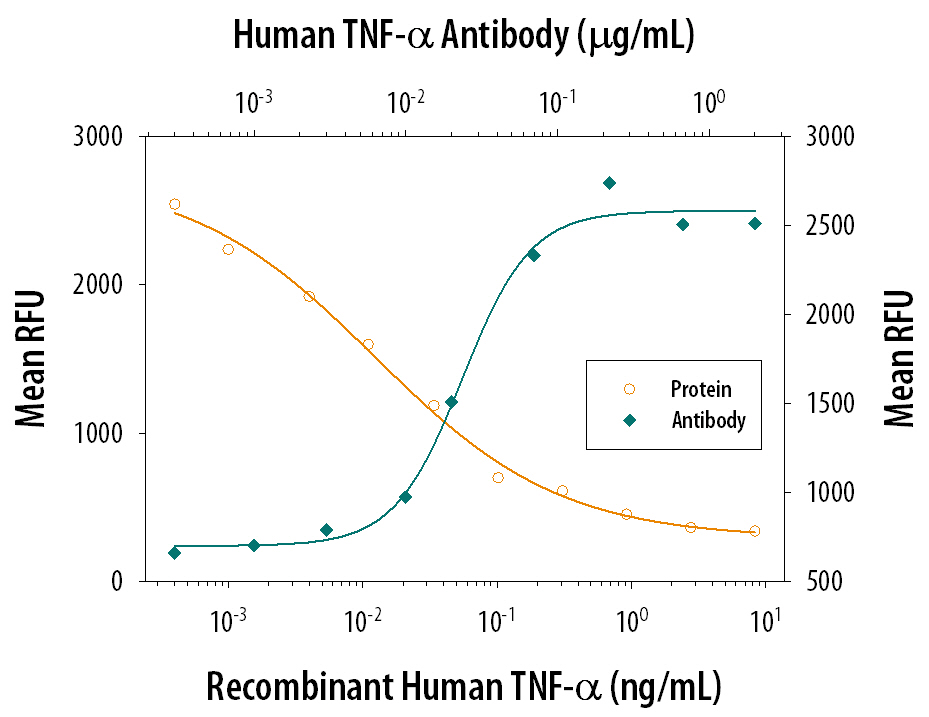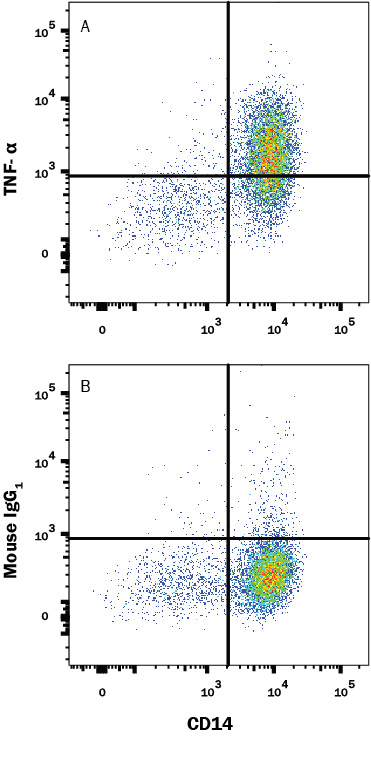Human TNF-alpha Antibody Summary
Gly57-Leu233 (predicted)
Accession # P01375
Applications
Please Note: Optimal dilutions should be determined by each laboratory for each application. General Protocols are available in the Technical Information section on our website.
Scientific Data
 View Larger
View Larger
Cytotoxicity Induced by TNF‑ alpha and Neutralization by Human TNF‑ alpha Antibody. Recombinant Human TNF-a (Catalog # 210-TA) induces cytotoxicity in the L-929 mouse fibroblast cell line in a dose-dependent manner (orange line). Cytotoxicity elicited by Recombinant Human TNF-a (0.25 ng/mL) is neutralized (green line) by increasing concentrations of Human TNF-a Monoclonal Antibody (Catalog # MAB2101). The ND50 is typically 0.015-0.06 µg/mL in the presence of the metabolic inhibitor actinomycin D (1 µg/mL).
 View Larger
View Larger
Detection of TNF‑ alpha in Human PBMC Monocytes by Flow Cytometry. Human PBMCs were treated with 1μg/ml LPS for 4 hours then stained with (A) Mouse Anti-Human TNF-a Membrane Form Monoclonal Antibody (Catalog # MAB2101) or (B) isotype control antibody (MAB002) followed by anti-Mouse IgG PE-conjugated Secondary Antibody (F0102B) and Mouse anti-Human CD14 APC-conjugated Monoclonal Antibody (FAB3832A). Staining was perfomed using our Staining Membrane-associated Proteins protocol.
Reconstitution Calculator
Preparation and Storage
- 12 months from date of receipt, -20 to -70 °C as supplied.
- 1 month, 2 to 8 °C under sterile conditions after reconstitution.
- 6 months, -20 to -70 °C under sterile conditions after reconstitution.
Background: TNF-alpha
Tumor necrosis factor alpha (TNF-alpha, TNF- alpha, TNFA ), also known as Cachectin and TNFSF2, is the prototypic ligand of the TNF superfamily. It is a pleiotropic molecule that plays a central role in inflammation, immune system development, apoptosis, and lipid metabolism. TNF- is produced by several lymphoid cells as well as by astrocytes, endothelial cells, and smooth muscle cells. Human TNF-alpha consisits of a 35 amino acid (aa) cytoplasmic domain, a 21 aa transmembrane segment, and a 177 aa extracellular domain (ECD). Within the ECD, human TNF-alpha shares 97% aa sequence identity with rhesus and 71%-92% with bovine, canine, cotton rat, equine, feline, mouse, porcine, and rat TNF-alpha. TNF-alpha is produced by a wide variety of immune, epithelial, endothelial, and tumor cells. TNF-alpha is assembled intracellularly to form a noncovalently linked homotrimer which is expressed on the cell surface. Cell surface TNF-alpha can induce the lysis of neighboring tumor cells and virus infected cells, and it can generate its own downstream cell signaling following ligation by soluble TNFR I. Shedding of membrane bound TNF-alpha by TACE/ADAM17 releases the bioactive cytokine, a 55 kDa molecular weight soluble trimer of the TNF-alpha extracellular domain. TNF-alpha binds the ubiquitous 55-60 kDa TNF RI and the hematopoietic cell-restricted 80 kDa TNF RII, both of which are also expressed as homotrimers present on virtually all cell types. Both type I and type II receptors bind TNF-alpha with comparable affinity, although only TNF RI contains a cytoplasmic death domain which triggers the activation of apoptosis. Soluble forms of both types of receptors are released and can neutralize the biological activity of TNF-alpha.
Product Datasheets
Citations for Human TNF-alpha Antibody
R&D Systems personnel manually curate a database that contains references using R&D Systems products. The data collected includes not only links to publications in PubMed, but also provides information about sample types, species, and experimental conditions.
8
Citations: Showing 1 - 8
Filter your results:
Filter by:
-
Strain-Modulated and Nanorod-Waveguided Fluorescence in Single Zinc Oxide Nanorod-Based Immunodetection
Authors: Sytu, MRC;Stoner, A;Hahm, JI;
Biosensors
Species: N/A
Sample Types: Small Molecule
Applications: ELISA Capture -
Peficitinib improves bone fragility by recovering bone turnover imbalance in arthritic mice
Authors: S Sugahara, K Hanaoka, T Emori, N Takeshita, Y Fujii, M Nakano, T Suzuki, J Takahashi, Y Nakamura
Journal of pharmacological sciences, 2021-11-03;148(1):134-141.
Species: Human
Sample Types: Whole Cells
Applications: Neutralization -
Periodontitis-associated pathogens P. gingivalis and A. actinomycetemcomitans activate human CD14(+) monocytes leading to enhanced Th17/IL-17 responses
Authors: Wan-Chien Cheng
Eur J Immunol, 2016-08-01;0(0):.
Species: Human
Sample Types: Whole Cells
Applications: Neutralization -
Vitamin D regulates cytokine patterns secreted by dendritic cells to promote differentiation of IL-22-producing T cells.
Authors: Sommer A, Fabri M
PLoS ONE, 2015-06-24;10(6):e0130395.
Species: Human
Sample Types: Whole Cells
Applications: Neutralization -
Innate lymphoid cells integrate stromal and immunological signals to enhance antibody production by splenic marginal zone B cells.
Authors: Magri G, Miyajima M, Bascones S, Mortha A, Puga I, Cassis L, Barra C, Comerma L, Chudnovskiy A, Gentile M, Llige D, Cols M, Serrano S, Arostegui J, Juan M, Yague J, Merad M, Fagarasan S, Cerutti A
Nat Immunol, 2014-02-23;15(4):354-64.
Species: Human
Sample Types: Whole Cells
Applications: Neutralization -
Production of interleukin 22 but not interleukin 17 by a subset of human skin-homing memory T cells.
Authors: Duhen T, Geiger R, Jarrossay D, Lanzavecchia A, Sallusto F
Nat. Immunol., 2009-07-05;10(8):857-63.
Species: Human
Sample Types: Whole Cells
Applications: Neutralization -
Der p 1 suppresses indoleamine 2, 3-dioxygenase in dendritic cells from house dust mite-sensitive patients with asthma.
Authors: Maneechotesuwan K, Wamanuttajinda V, Kasetsinsombat K, Huabprasert S, Yaikwawong M, Barnes PJ, Wongkajornsilp A
J. Allergy Clin. Immunol., 2008-12-05;123(1):239-48.
Species: Human
Sample Types: Whole Cells
Applications: Flow Cytometry -
A novel mechanism of CD40-induced apoptosis of carcinoma cells involving TRAF3 and JNK/AP-1 activation.
Authors: Georgopoulos NT, Steele LP, Thomson MJ, Selby PJ, Southgate J, Trejdosiewicz LK
Cell Death Differ., 2006-01-20;13(10):1789-801.
Species: Human
Sample Types: Whole Cells
Applications: Flow Cytometry, Neutralization
FAQs
-
Does Human TNF-alpha antibody, clone # 6401, detect membrane bound or soluble TNF-alpha?
Human TNF-alpha antibody, Clone # 6401, binds to and neutralizes Catalog # 210-TA, which is an E. coli-derived human TNF-alpha protein, Val77-Leu233, and has been shown to be cytotoxic to L‑929 mouse fibroblast cells. According to Uniprot, the soluble form of TNF-alpha is amino acids 77-233: https://www.uniprot.org/uniprot/P01375. We have also shown binding of Clone # 6401 to the membrane bound form of TNFa via flow cytometry. We are aware of a few citations showing the antibody acts to neutralize TNFa. See https://www.rndsystems.com/products/human-tnf-alpha-antibody-6401_mab2101#product-citations. Therefore, clone #6401 detects both membrane bound and soluble forms of TNF-alpha.
Reviews for Human TNF-alpha Antibody
There are currently no reviews for this product. Be the first to review Human TNF-alpha Antibody and earn rewards!
Have you used Human TNF-alpha Antibody?
Submit a review and receive an Amazon gift card.
$25/€18/£15/$25CAN/¥75 Yuan/¥2500 Yen for a review with an image
$10/€7/£6/$10 CAD/¥70 Yuan/¥1110 Yen for a review without an image













